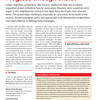Population dynamics and rural development in Burkina Faso
Few societies are more strongly characterised by migration and its repercussions than Burkina Faso. In the first 40 years following the country's independence, half of its citizens had a history of migration, either of cross-border labour migration, predominantly to Côte d?Ivoire, or of permanent resettlement within the country (from one rural area to another).
The scope of emigration meant population growth appeared relatively slow, despite very high natural growth (at 3.4% during the 1990s). Agricultural production was also able to hold pace with demographic growth, although the amount of land under cultivation remained static. The political crisis in Côte d'Ivoire, which began in 1999 and peaked between 2002 and 2004, led to the return of around 400,000 migrants and stemmed the flow of emigrants, bringing this positive scenario to an end.
Although agricultural production has outflanked population growth over the past decade, the area under cultivation has increased by 48 percent expansion which must soon cease due to limited natural resources.
Of the rural areas, where over three quarters of the population still reside, only a few have found good solutions to these challenging circumstances. One example is the Sud-Ouest region. Here, the interplay of intelligent population policy and programmes for rural development has helped turn short-term crisis response into a long-term solution.
Werner Heuler-Neuhaus
Sociologis, Independant Consultant
Ouagadougou, Burkina Faso
neuhaus@fasonet.bf
Florent Dirk Thies
Deutsche Gesellschaft für Internationale Zusammenarbeit (GIZ)
Ouagadougou, Burkina Faso
Florent-Dirk.Thies@gtz.de




